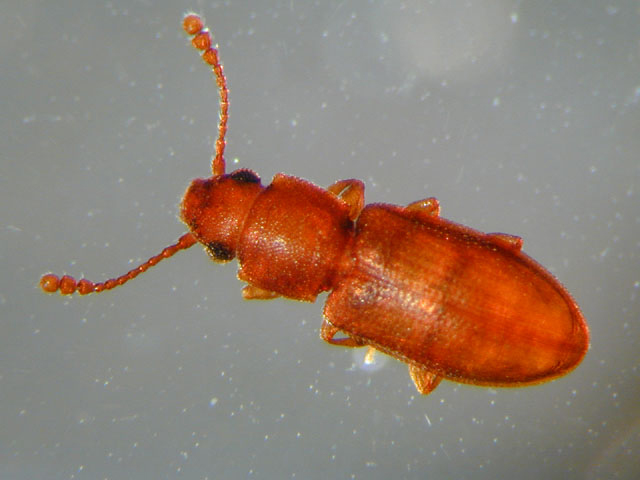News and Updates
What You Need to Know: Foreign Grain Beetles
(article courtesy of Seaira Global; https://seairaglobal.com/)
One of the issues with excess humidity in your home is the increased risk of pests. While some pests, like powderpost beetles, are attracted to moisture because they need water to survive, foreign grain beetles are different. These beetles aren’t attracted to the water itself, but rather the mold caused by the excess moisture.
Foreign grain beetles, a type of fungus beetle, are usually a camel brown color and approximately 1/16 inch long. They can be difficult to distinguish without a microscope, but are typically identified by two rounded lobes on the front corners of the thorax. Foreign grain beetles are covered in short, fine hairs plus dimple-like punctures.
The foreign grain beetle is most likely to be discovered from late July to September, especially after a period of heavy rain. The beetles are attracted to light and thus, more likely to be seen in summer months. They feed on mold spores and hyphae of fungi so damp, humid conditions are ideal. Foreign grain beetles are also commonly found in new construction homes where there is often uncured wood, moist sheetrock or freshly plastered walls. Plumbing leaks, poor ventilation, and high humidity also increase the risk of having foreign grain beetles.
The eggs of foreign grain beetles are laid on the surface of mold and usually hatch within 4-5 days. Foreign grain beetles thrive at warm, humid conditions and temperature will actually affect their life cycle. At 75°F, they will live an average of 25-36 days. At 65°F, the beetles will live an average of 54 days. Furthermore, larvae need high humidity to survive. There is a 0% survival rate at 66% relative humidity level.
It can be difficult to locate the source of a foreign grain beetle infestation since they can be in almost anywhere from moldy wallpaper to moist window cases. If an infestation is discovered, the best remedy is to dry out the moisture as quickly as possible. This will prevent more mold growth as well as reduce the foreign grain beetle population. Fungicides are often used to treat the mold, however, pesticides generally aren’t effective for treating foreign grain beetles.
There are also steps you can take to prevent an infestation from happening again. For instance, it’s crucial to make sure that problematic areas, such as basements or crawl spaces are maintained at a suitable humidity level and properly ventilated. This is where a dehumidifier can be helpful. Additionally, maintaining good sanitation and properly storing food in your home is helpful for preventing foreign grain beetles.
While a pest infestation is never ideal, the good news is that foreign grain beetles are not destructive to your home. If foreign grain beetles are found in your home, it is generally easy to control by getting the moisture levels under control The worst part of an infestation is ensuring that the mold is taken care of. As with most pests, if you actively maintain the humidity you can reduce your risk of an infestation.
Merchant, Michael. “Mildew-Feeding Insects in the Home.” Insects in the City, Texas A&M Agrilife Extension, citybugs.tamu.edu/factsheets/household/misc-house/ent-2010/.
Potter, Mike. “Foreign Grain Beetle.” Entomology at University of Kentucky, University of Kentucky College of Agriculture, Food, and Environment, Apr. 16AD, entomology.ca.uky.edu/ef610.
Shetlar, David J. “Fungus Beetles.” Ohio State University Extension, Ohio State University College of Food, Agricultural, and Environmental Sciences, 19 Oct. 2011, ohioline.osu.edu/factsheet/HYG-2084-10.
for more articles visit seairaglobal.com
Knowing How a Dehumidifier Works


